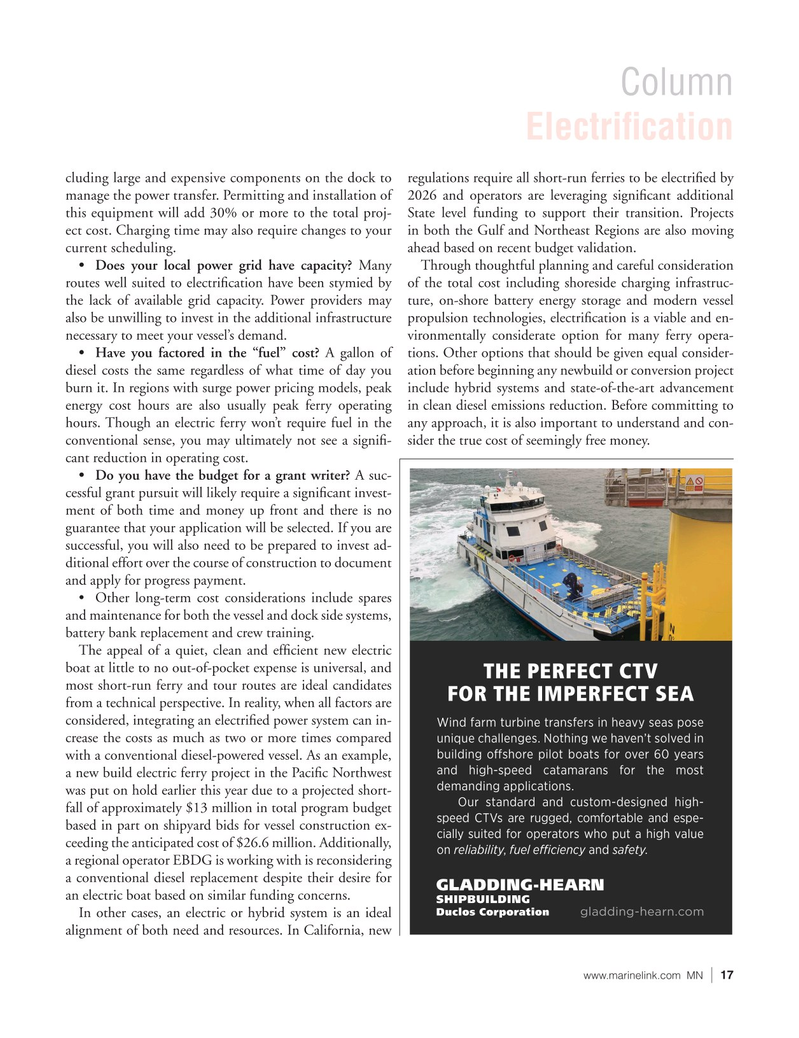
Page 17: of Marine News Magazine (October 2024)
Read this page in Pdf, Flash or Html5 edition of October 2024 Marine News Magazine
Column
Electrifcation cluding large and expensive components on the dock to regulations require all short-run ferries to be electrifed by manage the power transfer. Permitting and installation of 2026 and operators are leveraging signifcant additional this equipment will add 30% or more to the total proj- State level funding to support their transition. Projects ect cost. Charging time may also require changes to your in both the Gulf and Northeast Regions are also moving current scheduling. ahead based on recent budget validation.
• Does your local power grid have capacity? Many Through thoughtful planning and careful consideration routes well suited to electrifcation have been stymied by of the total cost including shoreside charging infrastruc- the lack of available grid capacity. Power providers may ture, on-shore battery energy storage and modern vessel also be unwilling to invest in the additional infrastructure propulsion technologies, electrifcation is a viable and en- necessary to meet your vessel’s demand. vironmentally considerate option for many ferry opera- • Have you factored in the “fuel” cost? A gallon of tions. Other options that should be given equal consider- diesel costs the same regardless of what time of day you ation before beginning any newbuild or conversion project burn it. In regions with surge power pricing models, peak include hybrid systems and state-of-the-art advancement energy cost hours are also usually peak ferry operating in clean diesel emissions reduction. Before committing to hours. Though an electric ferry won’t require fuel in the any approach, it is also important to understand and con- conventional sense, you may ultimately not see a signif- sider the true cost of seemingly free money.
cant reduction in operating cost.
• Do you have the budget for a grant writer? A suc- cessful grant pursuit will likely require a signifcant invest- ment of both time and money up front and there is no guarantee that your application will be selected. If you are successful, you will also need to be prepared to invest ad- ditional effort over the course of construction to document and apply for progress payment.
• Other long-term cost considerations include spares and maintenance for both the vessel and dock side systems, battery bank replacement and crew training.
The appeal of a quiet, clean and effcient new electric boat at little to no out-of-pocket expense is universal, and most short-run ferry and tour routes are ideal candidates from a technical perspective. In reality, when all factors are considered, integrating an electrifed power system can in- crease the costs as much as two or more times compared with a conventional diesel-powered vessel. As an example, a new build electric ferry project in the Pacifc Northwest was put on hold earlier this year due to a projected short- fall of approximately $13 million in total program budget based in part on shipyard bids for vessel construction ex- ceeding the anticipated cost of $26.6 million. Additionally, a regional operator EBDG is working with is reconsidering a conventional diesel replacement despite their desire for an electric boat based on similar funding concerns.
In other cases, an electric or hybrid system is an ideal alignment of both need and resources. In California, new www.marinelink.com MN 17|

 16
16

 18
18
